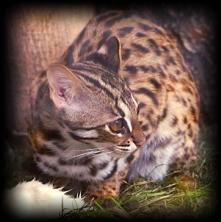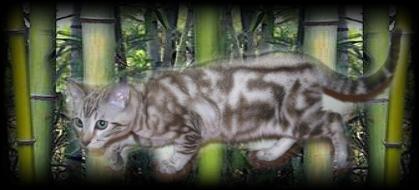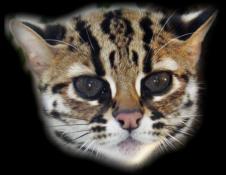|


The
Bengal Cat Breed
Portions
of this page are courtesy of Wikipedia
(the free encyclopedia),
please review the Copyright page for
further information.
The
Bengal
cat is a relatively new breed of domestic house cat ( Felis silvestris
catus ) developed to have a gentle and friendly temperament, while
exhibiting the markings (such as spots, rosettes, and a light/white
belly), and body structure reminiscent of the wild Asian Leopard cat , Prionailurus bengalensis.
Put another way, a Bengal cat has a desirable
'wild' appearance, with a gentle domestic cat temperament.
Bengals
are medium sized cats - a male may weigh as much as 20 lb (9 kg), and a
female commonly weighs 7 to 12 lb (4 to 6 kg). Male cats are
generally
larger than females. They are a great size for sitting on your lap while you're watching TV or playing games at http://www.foxybingo.com/ or whatever it is you choose to do to relax.
Bengals are known for being lap cats, they love a cuddle and will purr with delight when they get what they want.
 Bengal
cats are a hybrid breed developed over several generations through a
program of selectively crossbreeding domestic cats, possessing desired
features, with Asian Leopard Cats (ALC) and ALC hybrids. The
principle
of hybrid vigor dictates that hybrid cats are often healthier and
larger than either parent. The first three generation males are
almost
always infertile, though there have been the occasional, but rare F3
studs capable of reproduction. The early generation females are
typically fertile, and responsible for continuing the genetic
contributions of the ALC to the next generation. Bengal
cats are a hybrid breed developed over several generations through a
program of selectively crossbreeding domestic cats, possessing desired
features, with Asian Leopard Cats (ALC) and ALC hybrids. The
principle
of hybrid vigor dictates that hybrid cats are often healthier and
larger than either parent. The first three generation males are
almost
always infertile, though there have been the occasional, but rare F3
studs capable of reproduction. The early generation females are
typically fertile, and responsible for continuing the genetic
contributions of the ALC to the next generation.
The
first
three generations of these hybrid offspring are properly referred to as
the "filial" generations. A Bengal cat with an ALC parent is
called an
F1 Bengal, short for first filial. An F1 then bred with a
domestic male
yields an F2, or second filial. Kittens from an F2 female and
another
domestic cat are then termed F3. Kittens from a subsequent F3
mating
with a domestic are F4s. The F4 and later generations are
considered
domestic cats and correctly designated as Stud Book Tradition (SBT)
Bengals, and can be shown and registered. Any SBT bengal is at
least
four generations from the ALC. Filial cats (F1-F3) are also
termed
'foundation cats' and are typically reserved for breeding purposes, or
the specialty pet home environment.
A Bengal
cat purchased as a pet is usually an SBT. Although some
breeders
occasionally offer filial (F1-F3) cats for sale, they are not for the
average pet owner as early generation cats can be more aloof in
temperament and not as easily housebroken. The ALC in its
natural
setting is a solitary, small, shy and reclusive cat not known for
interacting with humans. The purpose of crossbreeding them
with
domestic cats was to obtain a wild-appearing cat with a desirable
friendly personality and gentle temperament.
 The
modern
SBT bengal gene pool contains genes sourced from many varieties of
domestic cats - mainly Egyptian Maus , American Shorthair , Abyssinian
, Ocicat , and domestic short haired cats . It is commonly
accepted that
the breed was developed by Jean Mill of California in the 1970's,
although bengal breeders exist throughout the world today. Many
breeders today are working to develop specific characteristics in the
breed, often by backcrossing foundation cats with particularly vivid
markings. The Asian Leopard Cat is comprised of several
subspecies, and
consequently, they can have considerable variations in their appearance. The
modern
SBT bengal gene pool contains genes sourced from many varieties of
domestic cats - mainly Egyptian Maus , American Shorthair , Abyssinian
, Ocicat , and domestic short haired cats . It is commonly
accepted that
the breed was developed by Jean Mill of California in the 1970's,
although bengal breeders exist throughout the world today. Many
breeders today are working to develop specific characteristics in the
breed, often by backcrossing foundation cats with particularly vivid
markings. The Asian Leopard Cat is comprised of several
subspecies, and
consequently, they can have considerable variations in their appearance.
Bengal cats are very
high-energy, intelligent, and
curious, and so are particularly interactive with their human
house mates, wanting to be in the middle of whatever the human is
engaged in, and often following the human around the house as household
chores are performed. As their activity and play requirements are
high,
this is not a cat best left to its own devices for long periods of
time, as they can be quite mischievous and destructive when
bored. If
an owner is likely to spend much of the day away from the cat, having
another high-energy feline companion to occupy your Bengal is an
excellent idea. Bengals tend to vocalize to communicate with
their
humans, and are quite capable of jealousy and spitefulness if they feel
that another feline is getting more attention, or if they are being
ignored. The other side of this coin is that they are also
extremely
affectionate towards and playful with their humans.
 Colors
and
Patterns Colors
and
Patterns
Bengals
are bred in a variety of colors and patterns. The
most common and accepted are:
- Brown Spotted Tabby -
Eyes: Green, depth of color varies.
- Brown Marbled Tabby -
Eyes: Green, depth of color varies.
The
Brown Tabby
Bengals have dark spots on a lighter ground color
ranging from gray or tawny to sorrel to golden, very rufused (bright
orange) and to a rich mahogany. Note: The Asian Leopard Cat is
considered a "brown spotted tabby" in the cat fancy and ranges somewhat
in color.
- Seal Lynx Spotted
Tabby - Eyes: Blue.
- Seal Lynx Marbled
Tabby - Eyes: Blue.
- Seal Sepia Spotted
Tabby - Eyes: Gold or Green/Gold.
- Seal Sepia Marbled
Tabby - Eyes: Gold or Green/Gold.
Sepia Tabby, (also
referred to as "Snow" Tabbies) have ivory backgrounds with
contrasting spots. Extreme contrast between the markings and the
ground
color is desirable in every color.
- Seal Mink Spotted
Tabby - Eyes: Green or Aqua.
- Seal Mink Marbled
Tabby - Eyes: Green or Aqua.
Mink
Tabbies (also
referred to as
"Snow" Tabbies) have ivory
backgrounds with
contrasting spots. The seal mink (aqua or green-eyed) spotted is
a
combination of one each of the above pointed Siamese and the Burmese
sepia genes. Extreme contrast between the markings and the ground
color
is desirable in every color.
- Silver Spotted Tabby
( Eyes: Green )
- Silver Marbled Tabby
( Eyes: Green )
Silver
Tabbies are
relatively new to the "Bengal World". Silver Tabbies
have silver backgrounds with contrasting spots. Extreme contrast
between the markings and the ground color is desirable in every color.
There
are
other types of colors of Bengals "out-there" being bred. To us,
these Bengals lose some of the "wild
appearance" that the Bengal Breed
strives for. Color and Markings are a big part of the breed, if
not the
biggest. To us these colors have a bit more of a domestic
appearance. Therefore, we
choose NOT to breed the
following colors: Black (Melanistic),
Blue, and
Torbie.
 Other
Coat
Characteristics: Other
Coat
Characteristics:
- "Glitter":
The high shine (usually on a clear, non ticked coat) that has been
discovered and developed in the Bengal is a welcome addition to the
breed.
- "Rosettes":
The dark outlining of coat markings (both in the spotted and marbled)
that are around a third rich color, are found in many Asian Leopard
Cats and other wild cat species. Rosettes showing two distinct
colors
or shades, such as paw print shaped, arrowhead shaped, doughnut or
half-doughnut shaped or clustered are preferred to single spotting but
not required.
- "Marbled":
The Marbled Tabby gene creates the marbled Bengal and represents a
change of pattern from spotted to swirled or marbleized. This
dramatic
pattern is comprised of swirls of brown spotted colors flowing in a
horizontal fashion instead of traditional spots. Preference is
given to
the more horizontal, flowing and "ocelot-like" patterns. The
"marbled"
pattern can also occur in lynx, sepia, mink, and silver color/patterns.
- "Fuzzy
Uglies": Some Bengal kittens go through what is referred to as
the
"fuzzy uglies" stage. A beautifully clear kitten at three weeks
old may
begin to acquire a "ticked" kitten coat at four to five weeks
old. This
coat begins to clear again to higher contrast at about 12 weeks and is
again breathtaking by 6 months.
 Official
Bengal Breed Standard: Official
Bengal Breed Standard:
Please
visit www.tica.org
to
read the official "Breed Standard" as set forth by TICA (The
International Cat Association).
|
|









 Bengal
cats are a hybrid breed developed over several generations through a
program of selectively crossbreeding domestic cats, possessing desired
features, with Asian Leopard Cats (ALC) and ALC hybrids. The
principle
of hybrid vigor dictates that hybrid cats are often healthier and
larger than either parent. The first three generation males are
almost
always infertile, though there have been the occasional, but rare F3
studs capable of reproduction. The early generation females are
typically fertile, and responsible for continuing the genetic
contributions of the ALC to the next generation.
Bengal
cats are a hybrid breed developed over several generations through a
program of selectively crossbreeding domestic cats, possessing desired
features, with Asian Leopard Cats (ALC) and ALC hybrids. The
principle
of hybrid vigor dictates that hybrid cats are often healthier and
larger than either parent. The first three generation males are
almost
always infertile, though there have been the occasional, but rare F3
studs capable of reproduction. The early generation females are
typically fertile, and responsible for continuing the genetic
contributions of the ALC to the next generation. The
modern
SBT bengal gene pool contains genes sourced from many varieties of
domestic cats - mainly Egyptian Maus , American Shorthair , Abyssinian
, Ocicat , and domestic short haired cats . It is commonly
accepted that
the breed was developed by Jean Mill of California in the 1970's,
although bengal breeders exist throughout the world today. Many
breeders today are working to develop specific characteristics in the
breed, often by backcrossing foundation cats with particularly vivid
markings. The Asian Leopard Cat is comprised of several
subspecies, and
consequently, they can have considerable variations in their appearance.
The
modern
SBT bengal gene pool contains genes sourced from many varieties of
domestic cats - mainly Egyptian Maus , American Shorthair , Abyssinian
, Ocicat , and domestic short haired cats . It is commonly
accepted that
the breed was developed by Jean Mill of California in the 1970's,
although bengal breeders exist throughout the world today. Many
breeders today are working to develop specific characteristics in the
breed, often by backcrossing foundation cats with particularly vivid
markings. The Asian Leopard Cat is comprised of several
subspecies, and
consequently, they can have considerable variations in their appearance.

